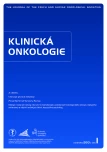Malignant Melanoma Treated with Radical Chemotherapy, Resemblance Histology of Melanoma to Soft Tissue Sarcomas, Case Report
Authors:
O. Bílek 1; Š. Tuček 1; K. Veselý 2; P. Fabian 3; B. Robešová 4; D. Adámková Krákorová 1; R. Lakomý 1; M. Svoboda 1
; A. Jurečková 1; J. Halámková 1; J. Králová 1; L. Šikulíncová 1; J. Podhorec 1; J. Tomášek 1
; I. Kiss 1
; R. Vyzula 1
Authors place of work:
Klinika komplexní onkologické péče, Masarykův onkologický ústav, Brno
1; I. patologicko-anatomický ústav LF MU a FN u sv. Anny v Brně
2; Oddělení klinické a experimentální patologie, Masarykův onkologický ústav, Brno
3; Interní hematologická a onkologická klinika, Centrum molekulární biologie a genové terapie LF MU a FN Brno
4
Published in the journal:
Klin Onkol 2013; 26(1): 42-46
Category:
Kazuistiky
Summary
Background:
Malignant melanoma is considered to be highly resistant to chemotherapy, radiotherapy, hormonotherapy and standard immunotherapy (interleukin 2, interferon alpha). Radical surgery in the early stages of the disease is still the most efficient method. Since the development of immunotherapy and targeted therapy, the role of palliative chemotherapy for advanced disease may be changing.
Case:
A case report regarding 44-year-old woman with extensive tumor of the pectoral wall with contralateral axillary lymphadenopathy is presented. On the basis of imaging methods, histology and immunohistochemistry, the tumor was defined as a sarcoma. Due to PAX7-FKHR fusion gene positivity, rhabdomyosarcoma was the most probable classification. The patient was treated with radical chemotherapy including iphosphamide, vincristine, actinomycin D and doxorubicin with the effect of partial regression of the tumor. This enabled radical surgery of the chest wall tumor. Pathology proved 70% necrosis of the tumor. A contralateral axillary dissection was performed with a finding of two lymph nodes infiltrated with melanoma. The immunohistochemistry markers S100, HMB-45 and Melan A were positive. This resulted in a reclassification of the chest wall tumor to malignant melanoma. The following PET/CT scan was negative. A massive progression of the disease occurred after 5 months. B-RAF mutation leads to a plan of targeted therapy with vemurafenib.
Conclusion:
The case demonstrates the limits of the sensitivity and specificity of immunohistochemical markers of melanoma and the ability of this tumor to imitate various tumors including soft tissue sarcomas. A rare PAX7-FKHR fusion gene positivity considered specific for rhabdomyosarcoma was found. An extraordinary response to radical chemotherapy with surgical resection led to an improvement of the quality of life and to a prolonged survival comparable with the effect of new targeted treatment for malignant melanoma.
Key words:
malignant melanoma – rhabdomyosarcoma – immunohistochemistry – cytogenetics – PAX7-FKHR – chemotherapy
Zdroje
1. Serrone L, Zeuli M, Sega FM et al. Dacarbazine-based chemotherapy for metastatic melanoma: thirty-year experience overview. J Exp Clin Cancer Res 2000; 19(1): 21–34.
2. Lee SM, Betticher DC, Thatcher N. Melanoma: chemotherapy. Br Med Bull 1995; 51(3): 609–630.
3. Hodi FS, O’Day SJ, McDermott DF et al. Improved survival with ipilimumab in patients with metastatic melanoma. N Eng J Med 2010; 363: 711–723.
4. Chapman PB, Hauschild A, Robert C et al. BRIM-3 Study Group. Improved survival with vemurafenib in melanoma with BRAF V600E mutation. N Engl Med 2011; 364(26): 2507–2516.
5. Alonso S, Rodríguez-Peralto JL, Ballestín C et al. Metastatic malignant melanoma with Homer-Wright rosettes mimicking a neuroblastic tumor. An unusual morphological manifestation. Virchows Arch 2003; 443(1): 108–110.
6. Bajčiová V, Štěrba J, Tomášek J et al. Nádory adolescentů a mladých dospělých. Grada; 2011; 91–100.
7. Barr FG, Chatten J, D‘Cruz CM et al. Molecular assays for chromosomal translocations in the diagnosis of pediatric soft tissue sarcomas. JAMA 1995; 273(7): 553–557.
8. Thomson B, Hawkins D, Felgenhauer J et al. RT-PCR evaluation of peripheral blood, bone marrow and peripheral blood stem cells in children and adolescents undergoing VACIME chemotherapy for Ewing‘s sarcoma and alveolar rhabdomyosarcoma. Bone Marrow Transplant 1999; 24(5): 527–533.
9. Blake J, Ziman MR. Aberrant PAX3 and PAX7 expression. A link to the metastatic potential of embryonal rhabdomyosarcoma and cutaneous malignant melanoma? Histol Histopathol 2003; 18(2): 529–539.
10. Karamchandani JR, Nielsen TO, van de Rijn M et al. Sox10 and S100 in the diagnosis of soft-tissue neoplazma. Appl Immunohistochem Mol Morphol 2012; 20(5): 445–450.
11. Mahmood MN, Lee MW, Linden MD et al. Diagnostic value of HMB-45 and anti-Melan A staining of sentinel lymph nodes with isolated positive cells. Mod Pathol 2002; 15(12): 1288–1293.
12. Pasz-Walczak G, Jesionek-Kupnicka D, Kubiak R et al. Rhabdomyosarcomatous (myoblastic?) phenotype of metastatic malignant melanoma. A case report. Pol J Pathol 2002; 53(2): 97–100.
13. Chung BY, Ahn IS, Cho SI et al. Primary malignant rhabdoid melanoma. Ann Dermatol 2011; 23 (Suppl 2): S155–S159.
14. Signorelli M, Lissoni AA, Garbi A et al. Primary malignant vaginal melanoma treated with adriamycin and ifosfamide: A case report and literature review. Gynecol Oncol 2005; 97(2): 700–703.
Štítky
Detská onkológia Chirurgia všeobecná OnkológiaČlánok vyšiel v časopise
Klinická onkologie

2013 Číslo 1
- Metamizol jako analgetikum první volby: kdy, pro koho, jak a proč?
- Nejasný stín na plicích – kazuistika
- Fixní kombinace paracetamol/kodein nabízí synergické analgetické účinky
- Antidepresivní efekt kombinovaného analgetika tramadolu s paracetamolem
- Geriatrická křehkost a léčba bolesti
Najčítanejšie v tomto čísle
- Germinatívne nádory pineálnej oblasti: prehľad
- Inhibitory proteazomu v léčbě mnohočetného myelomu
- Maligní melanom léčený intenzivní chemoterapií, podobnost histologického obrazu maligního melanomu a nádorů měkkých tkání, kazuistika pacientky
- Recidivující krvácení z jater a hemoperitoneum jako následek masivního postižení AL amyloidózou: popis případu a přehled literatury
